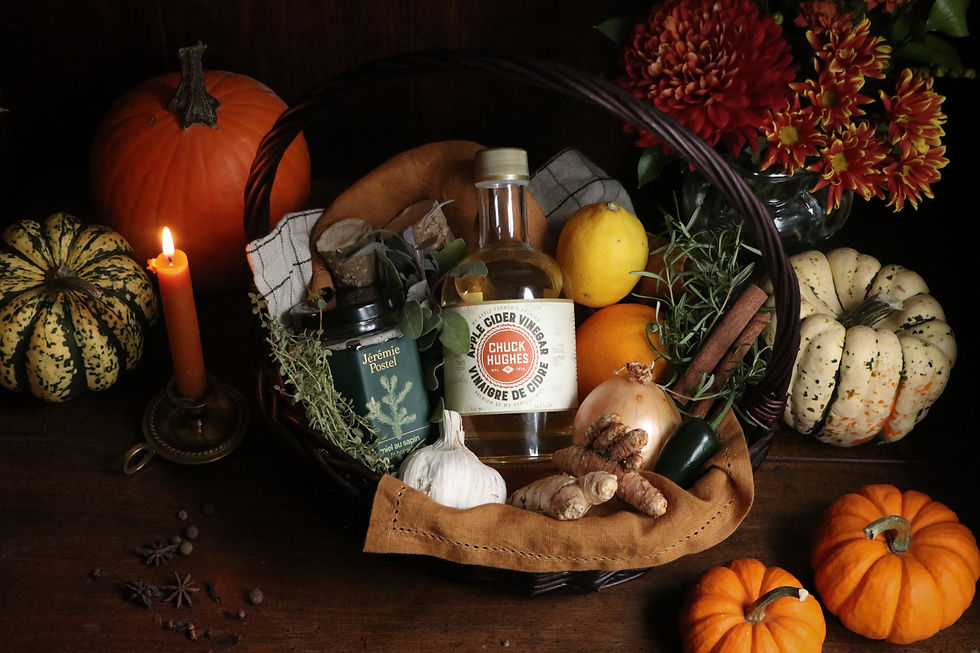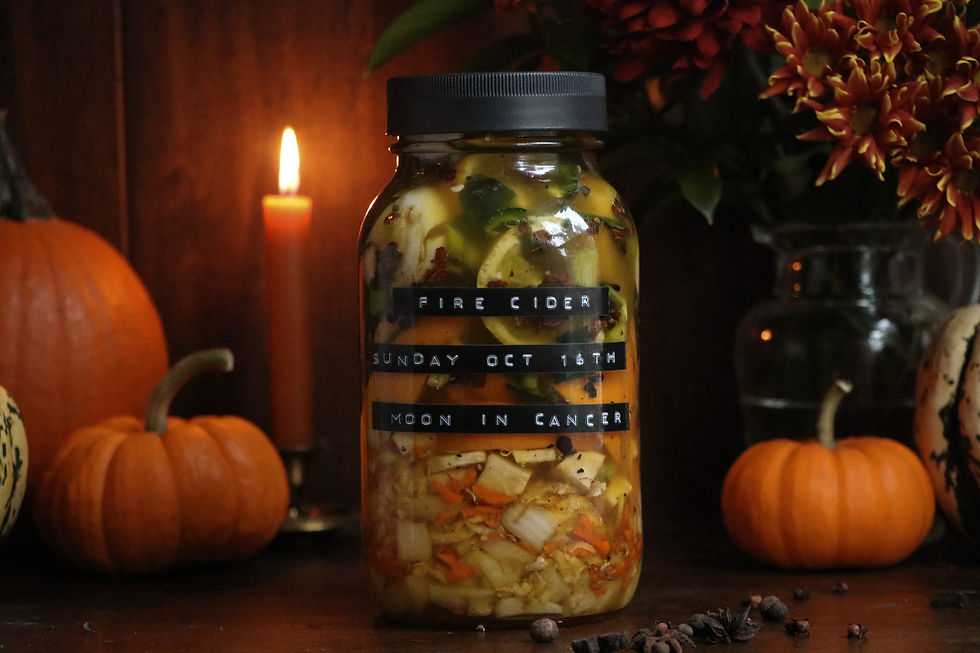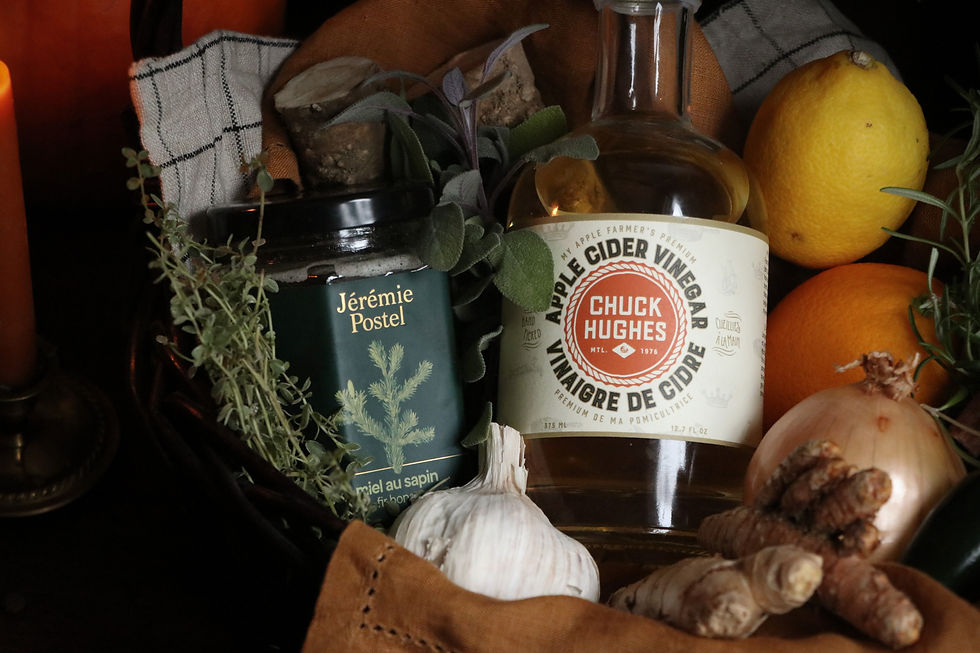Fire Cider
- mortifleur
- Oct 24, 2022
- 4 min read
Updated: Nov 19, 2022
As this vinegar tonic has recently gained more popularity, and you may have heard about it on social media, but this spicy brew is nothing new in the world of herbalism. Let me tell you more about it...

Traditional Fire Cider
A fire cider is an herbal preparation traditionally made in early fall to help support the immune system during the colder months. Most often than not, this brew is an Oxymel which is a preparation made with a mix of Apple Cider Vinegar (ACV) and Raw honey as a base, to which is added various herbs and spices.
There are as many recipes out there as there are herbalists, but the original formula of the Fire Cider is attributed to Rosemary Gladstar, although similar brews may have been prepared by certain cultures around the world well before the popularisation of it in the western world.
Her recipe (taken from the book Fire Cider! - 101 zesty recipes for health-boosting remedies made with apple cider vinegar) goes as follows:
Rosemary Gladstar's Recipe
Ingredients
• 1/2 cup grated horseradish root • 1/2 cup or more chopped onions • 1/4 cup or more chopped garlic • 1/4 cup or more grated ginger • Chopped fresh or dried cayenne pepper “to taste”. Can be whole or powdered. “To taste” means should be hot, but not so hot that you can’t tolerate it. Better to make it a little milder than too hot; you can always add more pepper later if necessary. • Raw honey • Unpasteurized apple cider vinegar • Optional ingredients: turmeric, echinacea, cinnamon, etc.
Directions
1. Place herbs in a half-gallon canning jar and cover with enough raw, unpasteurized apple cider vinegar to cover the herbs by at least three to four inches. Cover tightly with a tight-fitting lid.
2. Place jar in a warm location and let it infuse for three to four weeks. It is best to shake every day to help with the maceration process.
3. After three to four weeks, strain out the herbs and reserve the liquid. The strained herbs can be used to make chutney.
4. Add honey “to taste.” Your Fire Cider should taste hot, spicy, and sweet. “A little bit of honey helps the medicine go down……”
5. Rebottle and enjoy! Fire Cider will keep for several months unrefrigerated if stored in a cool pantry. But it’s better to store in the refrigerator if you have room.
How to Take: A small shot glass daily serves as an excellent preventative tonic. Or take several teaspoons throughout the day if you feel a cold coming on.

My Take On Fire Cider
Personally, I like to play around with the original recipe and make little variations every year. I find that it makes it unique, and I am always looking forward to discovering the taste that will be created from this new mix of ingredients.
One thing that is really important to me, is crafting my Fire Cider on a Sunday. Why? Because I practice astro-herbalism, which is a method that consists of aligning the practice of herbalism in correspondence with the cycles of the celestial bodies (planets, stars, moon) to expand the potency of the medicinal preparation. In this practice, every day of the week (and every hour of the day!) is attributed to a specific planet or astral body.
To me, it makes sense that preparing a warm and spicy brew full of vitamins to support the immune system during the time of the year when the Sun is lower and less present should be done on the day of the Sun (Sunday). It is also on a Sunday that I will strain my oxymel, 4 to 6 weeks later.
Like many other herbalists, I chose to incorporate the honey with the apple cider vinegar and all the other ingredients to infuse and ferment for 4-6 weeks, instead of adding the honey after you have strained your Fire Cider. But that is just a matter of preference and I suggest that you experiment a bit to find out what you prefer yourself.
Here are some ingredients that I always add to my personal preparation :
- Lemons
- Oranges or Grapefruit
- Herbs from the garden (rosemary, thyme, sage, etc.)
- Lemongrass
- Hot Peppers from the garden instead of cayenne pepper
- Turmeric
And then I will add different spices and ingredients depending on what is in season and what experiments I want to make. I have previously added any combination of the following list :
- Cloves
- Cinnamon
- Echinacea
- Hibiscus
- Star Anise
- All Spice
- Cedar
- Pine
- Spruce Tips
I also like to swap around the varieties of vegetables and plants that I use from year to year. For example, you could use a red onion instead of a yellow onion, blood oranges instead of regular ones, etc.
This year, I have decided to experiment with using a spruce tip infused honey that I got from a local beekeeper, hoping that it will add a special evergreen twist to the brew.

Important Tips
To make your recipe successful, I recommend following the tips below:
- Sterilize your jar, utensils, and work surface before making your Fire Cider to avoid contamination.
- Use fresh, organic ingredients. Especially if you use the peel of the oranges, and keep the skin on your ginger and turmeric roots because they could have been in contact with pesticides.
- Use a BPA-free plastic cap on your jar to avoid rust from a metal lid. Alternatively, place two sheets of parchment paper under your lid so your brew isn't touching the metal. Be careful when shaking your Fire Cider if you put parchment paper under your lid because it could leak a bit.
- Chop and grate your ingredients as small as possible to have more surface exposed to the ACV and get a better extraction out of it.
- Make sure you have way more ACV than Honey in your mixture. You shouldn't have more than 1 part honey to 4 parts ACV.
- Use within 6 months for maximum potency.

And that was my take on the traditional Fire Cider tonic, I hope you enjoyed learning and experimenting with me!
Happy Brewing,
Mortie
コメント